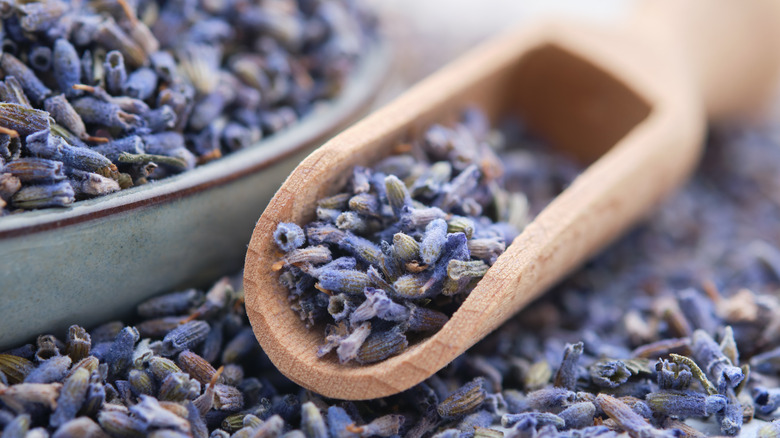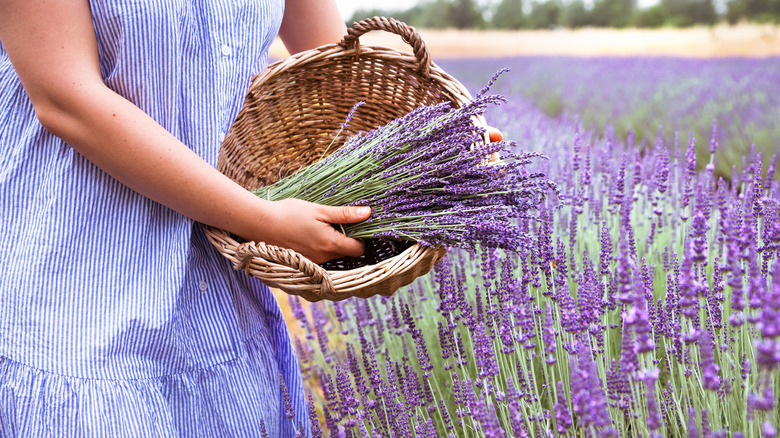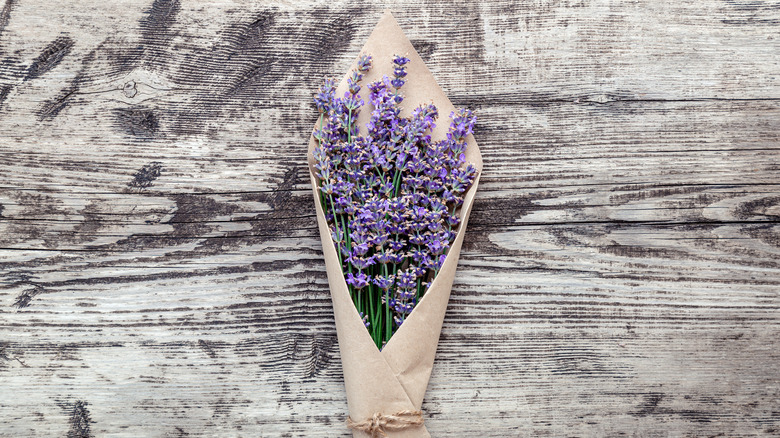How To Dry And Store Fresh Lavender For Cooking
Fresh lavender will have you seeing, smelling, and tasting flowers. When it comes to flavor, the fragrant plant is everywhere, bolstering lattes, muffins, oils, and more. Lavender puts a floral spin on any dish or drink, though you don't need to find it on a menu to taste it for yourself.
Rather, D.I.Y. lavender concoctions are as simple as they are vibrant, and require picking and choosing the best lavender for your purposes. You can purchase bags of already-dried lavender or acquire a lavender plant in its fresh, herbaceous form to dry for yourself. In plucking fresh lavender for cooking, look for distinctive shades of blue-purple. According to Bon Appétit, the flowers should smell clean and spicy rather than extremely fragrant.
Although incorporating fresh lavender into your cooking is seemingly a no-brainer, take your time to choose the best version. Given the range of lavender iterations — there are 47 types and 450 varieties — not all lavenders are equal. Opt for a version of the herb that is specific to cooking, known as culinary lavender. Per Serious Eats, many commercially available lavender plants are intended for potpourri and therefore infused with chemicals. If you don't know your lavender's source, you won't know the pesticides it may contain. It's, therefore, best to choose an organic, culinary lavender safe for consumption.
After you accumulate your lavender, you'll want to devise a game plan for storing and drying it. A few key steps will ensure your plant is ready for use — and that it retains enough flavor for whatever you're planning to make.
Leave lavender to dry naturally in the open-air
Once you harvest your lavender, you'll want to dry it out. Dried lavender holds smell and flavor for months and can be used more sparingly than a recently harvested version (via Martha Stewart). A teaspoon of dried lavender roughly equates to three teaspoons of the fresh plant.
There are a few strategies for drying lavender, and you'll have to decide which works best with your timeframe and kitchen amenities. If all you have is empty space and natural air, there are two easy options. The first calls for hang-drying your lavender. Bundle the plant's stems with a rubber band, before flipping them upside down to dangle on a nail or hook. HGTV suggests leaving lavender to dry in a dark, warm environment. This process takes roughly seven to 10 days.
Perhaps an even easier option is air-drying your lavender, which is as simple as it sounds. Leave lavender flat in a single layer. Per Masterclass, you can let the plant dry on your countertop or, as HGTV recommends, you can cover it on a deck or driveway. Once again, your lavender should be good to go within a week to 10 days.
Take advantage of kitchen appliances to expedite the drying process
If you're short on time or impatience gets the best of you, bake your lavender to speed up the drying process. Oven-drying is an easy and efficient strategy that will prepare your lavender for same-day cooking ... and with minimal effort. However, the timing and temperature required by oven-drying vary across sources. Bon Appétit suggests baking lavender on a sheet for roughly 10 minutes at 200 F. In a similar vein, Masterclass calls for setting your oven to 100 F, but baking the plant for up to 15 minutes. Whichever timing you choose, keep an eye on your lavender so it doesn't burn. Ovens tend to operate differently, and overcooked lavender will have you starting from scratch.
If you'd rather avoid the heat altogether, you can alternatively dehydrate your bunch in a food dehydrator. This process takes roughly two hours — leaving you plenty of time to chill an ice cream base if lavender-infused dairy is calling your name.
Store lavender in a neutral, sun-free environment
Once your lavender dries, you will likely need ample time to consume it. Remember: a pinch goes a long way. You'll have to store the lavender you don't use immediately upon drying. Food Network suggests saving dried lavender in a cool, dry setting. Make sure to keep it in an airtight container. If you'd rather hang onto fresh lavender, wrap the plant in a damp paper towel before refrigerating it. Fresh lavender will only last for days, however, so drying your lavender may prove most fruitful once again.
According to Bon Appétit, dried lavender can retain its taste and smell for roughly a year when stored properly. This longevity makes drying fresh lavender a long-term investment that will prime your tastebuds for summer cocktails, fall shortbreads, mid-winter hot chocolates, and a sprinkle of floral whenever inspiration strikes.



